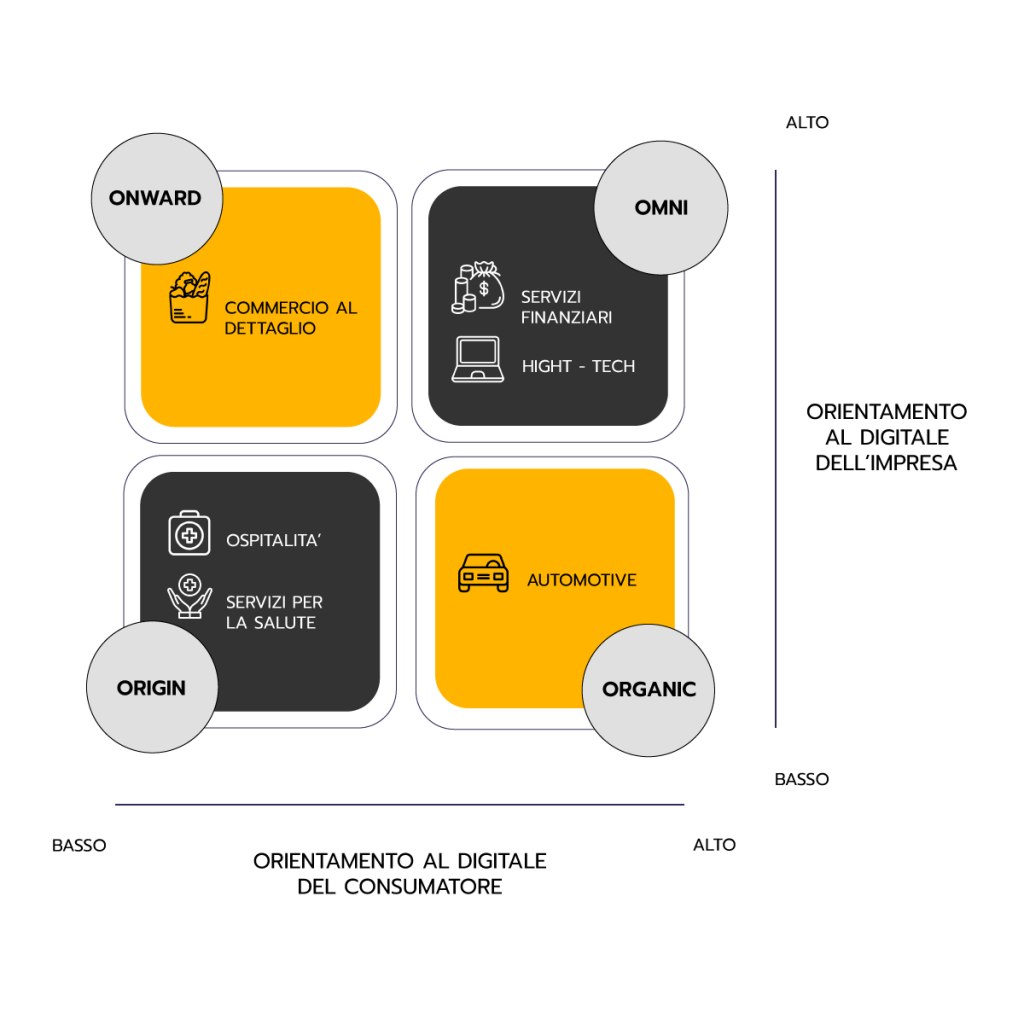Quando si parla di digitalizzazione non esiste un approccio valido per tutti.
Ogni settore produttivo e ogni singolo attore di ogni settore si trova in un diverso stadio di maturità digitale. Il primo passo è valutare l’orientamento della base di clienti per cui le imprese competono. Il passo successivo è l’autovalutazione delle capacità digitali dell’organizzazione.
A seconda dei risultati, le imprese possono poi definire e attuare strategie diverse, che possono includere la migrazione dei clienti su punti di contatto online e la definizione di strategie di trasformazione digitale.
Fornisco qui di seguito due strumenti che possono aiutare le organizzazioni a valutare la propria capacità di digitalizzare i processi e nel contempo aiutano a comprendere se il mercato in cui l’azienda opera, dal lato della domanda, è pronto e disposto a migrare verso una maggiore quantità di touchpoint digitali:
– Matrice dell’orientamento al digitale per settore;
– Scheda di valutazione del livello della transizione al digitale – che ho trasformato in un quiz super snello per le aziende
“CALCOLA IL TUO LIVELLO DI ORIENTAMENTO AL DIGITALE”
1. Matrice dell’orientamento al digitale per settore
Come anticipato, la valutazione della domanda e dell’offerta – ovvero a) stabilire se il consumatore è pronto a passare al digitale b) stimare la capacità dell’azienda di trasformarsi internamente per trarre vantaggio dalla migrazione verso il digitale – dà origine a una matrice che consente di stabilire la posizione di un’impresa all’interno di uno dei quadranti dell’orientamento al digitale:
– “ORIGIN” (ORIGINE) : basso orientamento al digitale sia dalla parte del consumatore che dell’impresa;
– “ONWARD” (IN AVANTI) : basso orientamento al digitale del consumatore ma alto orientamento al digitale dell’impresa;
– “ORGANIC” (ORGANICO) : alto orientamento al digitale del consumatore ma basso orientamento al digitale dell’impresa;
– “OMNI” (OMNICHANNEL) : alto orientamento al digitale sia dalla parte del consumatore che dell’impresa;
In altre parole:
Se i vostri processi aziendali includono interazioni fisiche rilevanti che sono molto difficili da eliminare o sostituire (es. settore dell’ospitalità, servizi per la salute), la vostra azienda si posiziona nel quadrante Origin.
Se la vostra impresa opera in settori, come la vendita al dettaglio, che hanno difficoltà a far migrare i clienti al digitale sebbene abbia investito molto nella digitalizzazione dei processi aziendali, si posiziona nel quadrante Onward.
Se la vostra impresa offre prodotti e servizi mediante touchpoint fisici e ha difficoltà a gestire collaboratori da remoto (es. industria automobilistica, concessionarie) ma è spinta dalla domanda ad adottare tecnologie digitali (es. acquisto di auto online, realtà virtuale per esplorare visivamente optional di un modello, manutenzione predittiva tramite IoT), vi collocate nel quadrante Organic.
Se la vostra impresa opera nel settore high-tech e finanziario o in settori in cui la digitalizzazione è parte importante del loro DNA, allora si posiziona nel quadrante Omni.
Per illustrare le quattro categorie rappresentate nella matrice, viene tipicamente valutato l’orientamento al digitale dei sei settori produttivi che non a caso ho citato come esempi: high-tech, servizi finanziari, vendita al dettaglio di generi alimentari, settore automobilistico, settore dell’ospitalità e settore sanitario.

Preciso fin da subito che la posizione di ogni settore nella matrice sopra è la “fotografia” della situazione attuale negli Stati Uniti. Può cambiare nel tempo con l’evolversi del mercato e in altri mercati i consumatori possono avere anche gradi diversi di orientamento al digitale così come i songoli operatori di ciascun settore. Nulla è definito per sempre.
“Ma quali sono le strategie di digitalizzazione che le imprese di ogni quadrante della matrice possono mettere in campo? “
Ecco qualche suggerimento.
Le imprese nei quadranti Origin e Onward devono fornire uno stimolo ai propri clienti per passare ai canali digitali; i loro customers trovano ancora valore nelle interazioni fisiche e pertanto hanno una scarsa motivazione per migrare al digitale.
Come agevolare allora questo passaggio?
Offrite un valore più elevato grazie alla customer experience online e mostrate i vantaggi dello spostarsi online. Una soluzione potrebbe essere quella di offrire incentivi monetari come cashback, sconti e promozioni solo per i consumatori che interagiscono mediante piattaforme digitali; i deterrenti possono assumere la forma di costi aggiuntivi se si seleziona una modalità offline durante le interazioni. Ricordate poi che l’interazione fisica ha delle debolezze intrinseche, in particolare per quanto riguarda le inefficienze: code e perdite di tempo sono le principali frustrazioni nei touchpoint offline e il digitale può essere la risposta al desiderio dei clienti di soluzioni rapide e dirette. Non dimenticate, infine, che personale incompetente e scarsa capacità di relazione sono alcune delle principali cause di reclamo, pertanto rendere disponibile un canale digitale alternativo potrebbe stimolare in cambiamento comportamentale.
Quando invece le interazioni in presenza creano valore e sono ancora desiderabili, potete utilizzare forme di comunicazione abilitate digitalmente: pensate al video banking nei servizi finanziari, alla consulenza virtuale nella telemedicina – approcci che consentono di realizzare economie ma nel contempo di mantenere i vantaggi dei touchpoint umani. Chatbot, assistenti virtuali possono in alcuni casi addirittura sostituire il personale di front line.
La sfida per le imprese collocate nei quadranti Origin e Onward è dunque quella dotarsi delle competenze per soddisfare i bisogni dei consumatori digitali.
Investite nell’infrastruttura – hardware, software e sistemi IT – per poter gestire e analizzare big data in tempo reale e sviluppate capacità organizzative per realizzare una cultura agile in azienda. Ripensate i vostri processi aziendali.
La digitalizzazione non si limita all’automazione delle operazioni di routine, spesso serve reingegnerizzare tutti il sistema delle attività delle attività per adattarlo alla nuova realtà digitale.
Di fronte alle crescenti aspetative dei consumatori, le imprese del quadrante Omni non devono restare ferme. Poichè altre imprese stanno guadagnando terreno, queste imprese sono costrette ad alzare l’asticella e devono rafforzare il proprio posizionamento come brand digital first.
Considerato che le generazioni Y e Z – i consumatori digitali per eccellenza – non si accontentano più di soluzioni di base, le imprese devono integrare tecnologie avanzate nella customer experience, quella che viene chiamata “la nuova CX”, sempre più fluida.
Le imprese del quadrante Omni non possono accontentarsi di content marketing e piattaforme e-commerce che sono fattori essenziali senza i quali non possono competere; devono potenziare la propria capacità startegica adottando tecnologie avanzate che non sono ancora diffuse. Usate l’intelligenza artificiale per potenziare le attività di marketing, installate sensori e applicate l’IoT per offrire touchpoint fisici ma alimentati digitalmente, vivacizzate le campagne di marketing con realtà virtuale o aumentata; concentratevi sull’offerta di una nuova CX a tre diversi livelli: informativo, interattivo, e immersivo.
2. Scheda di valutazione del livello della transizione al digitale
La scheda di valutazione del livello della transizione al digitale è il secondo strumento di autovalutazione aziendale che consiglio in quanto aiuta a riflettere su quei temi che le imprese spesso dimenticano di affrontare. Per restituire comunque un feedback e orientare le aziende verso la valutazione dello sviluppo di una strategia di digitalizzazione piuttosto che un’altra, ho preferito trasformare la scheda in un QUIZ online.
Ad ogni modo fornisco qui di seguito l’elenco puntato dei topics su cui ragionare, sia lato impresa che lato consumatore:
1. L’impresa è in grado di interagire digitalmente con i propri consumatori lungo i customer journey;
2. Tutti i touchpoint digitali possono essere integrati in una customer experience fluida e senza attriti;
3. L’impresa può creare valore e generare profitti mediante modelli di business digitale;
4. Sono disponibili tecnologie per raccogliere, archiviare, gestire e analizzare in tempo reale un grande volume di dati relativi ai consumatori;
5. I processi di business sono digitalizzati e reingegnerizzati per integrarsi al nuovo modello di business;
6. È stata implementata la digitalizzazione con l’IoT degli asset fisici come edifici, flotte aziendali e attrezzature;
7. La maggior parte dei collaboratori è dotata di dispositivi digitali per lavorare da remoto e collaborare nello spazio digitale;
8. La formazione di talenti digitali come data scientist, UX designer e architetti IT è una priorità assoluta;
9. Vi è una solida cultura digitale che abilita l’allineamento tra manager e talenti;
10. La maggioranza delle customer base è composta dalle generazioni y e z, che sono competenti nell’uso delle tecnologie digitali;
11. La maggior parte dei consumatori ha già sviluppato engagement con l’impresa ed effettua transazioni mediante piattaforme digitali;
12. Quando utilizzano o consumano prodotti o sevizi, i consumatori devono interagire con interfacce digitali;
13. I customer journey si svolgono già parzialmente o completamente online? (webrooming e showrooming: il consumer conduce ricerche online ma compra in negozio, o viceversa si informa e prova in negozio per poi comprare online);
14. I touchpoint fisici che i consumatori trovano frustanti possono essere sostituiti e potenziati da tecnologie digitali;
15. I consumatori possono accedere a una grande quantità di informazioni su internet per prendere autonomamente decisioni informate;
16. I consumatori ritengono che le interazioni digitali con l’impresa siano superflue, irrilevanti e prive di valore;
17. Prodotti e servizi sono ritenuti poco complessi, di conseguenza rischi e questioni legate alla fiducia sono limitati;
18. La maggior parte dei consumatori ha numerosi ha numerosi incentivi per migrare al digitale: più possibilità di scelta, prezzi migliori, qualità più alta, maggiore comodità;
FAI IL QUIZ e scopri il tuo livello di transizione al digitale!
10/02/22
Oriana Torregrossa | Digital & Communication Manager TDE
Source: Marketing 5.0 – Philip Kotler
